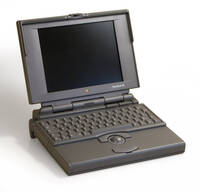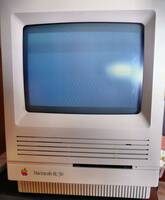Macintosh1 abreviado como Mac, es la línea de computadoras personales diseñada, desarrollada y comercializada por Apple Inc. En sus inicios fue una alternativa económica y doméstica al Lisa, un avanzado microcomputador empresarial, cuya línea de desarrollo fue absorbida por la línea Macintosh. El Mac terminó por convertirse en la línea estándar de desarrollo de los computadores de Apple, al desaparecer la línea evolutiva del Apple II.
El Macintosh 128K, llamado así a cuenta de sus 128 KiB de memoria RAM, fue lanzado el 24 de enero de 1984. Siendo el primer computador personal que se comercializó exitosamente,[cita requerida] que usaba una interfaz gráfica de usuario (GUI) y un ratón en vez de la línea de comandos. Sus características técnicas revolucionaron la industria de computadores a mediados de la década de 1980, manteniendo su línea evolutiva de desarrollo hasta el día de hoy.
Los primeros Macintosh estaban basados en los microprocesadores de la familia Motorola MC68000, de tecnología CISC. En marzo de 1994, Apple introdujo en la gama Macintosh los chips PowerPC del Consorcio Apple/IBM/Motorola, que suponían el cambio a la tecnología RISC. En 2006, Apple inició la transición desde la línea de PowerPC line a los procesadores Intel con arquitectura x86
Familia Compact:
Macintosh 128K 1984
Macintosh 512K 1984
Macintosh XL 1985
Macintosh Plus 1986
Macintosh 512Ke 1986
Macintosh SE 1987
Macintosh SE-30 1989
Macintosh SE FDHD 1989
Macintosh Classic 1990
Macintosh Classic II 1991
Macintosh Color Classic 1993
Macintosh Color Classic II 1993
Familia Mac II:
Macintosh II 1987
Macintosh IIx 1988
Macintosh IIcx 1989
Macintosh IIfx 1990
Macintosh IIsi 1990
Macintosh IIvi 1992
Macintosh IIvx 1992
Familia Portable:
Macintosh Portable 1989
Familia LC:
Macintosh LC 1990
Macintosh LC II 1992
Macintosh LC III - III+ 1993
Macintosh LC 520 1993
Macintosh TV 1993
Macintosh LC 550 1994
Macintosh LC 575 1994
Macintosh LC 580 1995
Familia Quadra:
Quadra 700 1991
Quadra 900 1991
Quadra 950 1992
Quadra 800 1993
Quadra 840AV 1993
Quadra 605 1993
Quadra 610 1993
Quadra 650 1993
Quadra 630 1994
Familia PowerBook:
PowerBook 100 1991
PowerBook 140 1991
PowerBook 170 1991
PowerBook 145 1992
PowerBook 160 1992
PowerBook 180 1992
PowerBook Duo 210 1992
PowerBook Duo 230 1992
PowerBook 165c 1993
PowerBook 145b 1993
PowerBook 180c 1993
PowerBook 165 1993
PowerBook Duo 250 1993
PowerBook Duo 270c 1993
...
Familia Centris:
Centris 610 1993
Centris 650 1993
Familia Power Macintosh:
Power Macintosh 6100 1994
Power Macintosh 7100 1994
Power Macintosh 8100 1994
Power Macintosh 6200-6300 1995
Power Macintosh 9500 1995
...
 video games gallery from the last century
video games gallery from the last century





















































